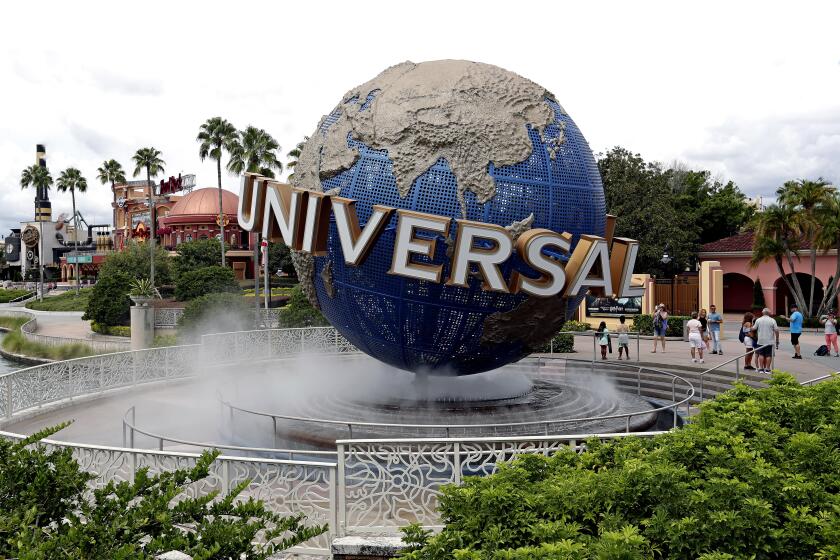‘Death Stranding’ is the weirdest, most lovingly imperfect game of 2019
The most talked about video game of 2019 will likely confound, occasionally bore and most definitely cause frustration.
“Death Stranding” will also fascinate.
To skip “Death Stranding” is to miss out on one of the weirdest and most lovingly imperfect narratives of the year. There’s even a “very easy” mode, which game auteur Hideo Kojima has joked is for “movie fans.” Even so, many non-gamers will miss out on “Death Stranding” because of its requirement, at least for now, of owning a PlayStation 4. That’s a shame, for while “Death Stranding’s” overcooked plot and incessant walking may turn some off, it’s a work that should be celebrated.
At a time when there’s a robust debate as to what is or isn’t cinema and the value of franchise works, “Death Stranding” is a bold statement about what a video game can be. In the hands of Kojima — the mastermind behind the “Metal Gear” series — a video game challenges, confuses, inspires curiosity and only succeeds if you meet the designer halfway. Its 60-or-so-hour narrative demands that its audience fully engage and forget whatever expectations come with a blockbuster game.
For all the talk of Kojima as a cinematic game developer — he’s considered a video game counter to filmmaker Guillermo del Toro, a pal whose likeness appears in the game — “Death Stranding” is tailored specifically for the interactive medium, failing to fully work if its participants aren’t in it together. The game asks us to put in the work, to learn its systems, its desires and its language.
“Death Stranding,” released after years of myth-building hype, at times makes the grotesque palatable. There’s a baby, for instance, in a jar, and the player regularly taps into its consciousness. It’s explained early on that the baby can recognize the dead who hover among us by somehow connecting with its brain-dead mother on life support. While arguably troubling on what this says about personal autonomy, it still somehow becomes normal, almost playful, about 10 or 15 hours in.
More discomfort comes rapidly. One of the game’s initial tasks has us taking the dead body of the first female president and tossing it into an incinerator. Yet this is for the good of the country, a proper burial in the world of “Death Stranding,” for to allow the deceased to decompose will see the worlds of the living and the dead collide to create a catastrophic, nuclear-like event.
“Death Stranding” presents us with a serious, somber hellscape, practically daring us to continue.
To embrace “Death Stranding” I had to stop fighting it. I had to learn that it constantly upends standard video game tactics.
In its opening moments we learn that the environment has become so perilous that rain — “timefall,” the game calls it, for its ability to hasten death — will destroy everything it touches. Ghost-like figures hover in the wilderness, attempting to touch the living and drown them in sludges of an oil-like substance. We learn that the main character is essentially a deliveryman, a working-class outcast cut off from the underground cities of future America.
Amid all these horrors, “Death Stranding” tries to tell us this is all for the best. For humanity to survive, it argues throughout, we’ll have to start from scratch, and it will be done on the backs of the working rather than the ruling class, the latter of whom apparently made a mess of everything in an earlier America, but you likely knew that before booting it up.
The game becomes a warning that such a scenario is what may in fact happen, albeit without the whale-like monsters that rise from something akin to an afterlife covered in thick, black liquid. They’re not quite whales and it’s not quite oil, but since “Death Stranding” is essentially a metaphor, we’ll declare them whales covered in oil, as the game throughout glances at our current climate crisis. The name of the game references a cryptic, supernatural event that destroyed the world, and nature here has fought back. If we’re not encountering mystical monsters who divorce us from our cargo that needs to be delivered, we’re struggling to walk or drive amid human-unfriendly landscapes, which also divorces us from our cargo.
These odd and potentially off-putting story beats, combined with early missions that essentially have the player — “The Walking Dead’s” Norman Reedus as the likable and gruff Sam Bridges — walking from one place to another and tumbling to the ground for merely stepping on a pebble, resulted in me strongly disliking “Death Stranding’s” first 10 to 15 hours. But I eventually grew quite fond of it, and now having played more than 45 hours, I’ve come to view most of it as quite calming, a game whose biggest terror is simply the fear of loneliness and how it can destroy someone.
I warmed up to “Death Stranding” for the way it hides optimism in a gravely cynical view of the world. While there’s nothing odd about the latter in 2019, “Death Stranding’s” primary message is one of hope. It ultimately falls perhaps too hard on its theme of better communication as a savior, complete with hokey dialogue about how we must learn to connect with strangers and over-communicate with those we love, but it manages over its course to go from coldly distant and borderline thrilling to somewhat heartwarming. For underlying this byzantine narrative is a burn-it-all-down approach to modern life, social media and long-lost American ideals, fueled by the idea that it’s still possible to build something better.
To embrace “Death Stranding” I had to stop fighting it. I had to learn that it constantly upends standard video game tactics. Sam Bridges, for instance, is largely powerless, as the game’s vast wilderness regularly reminds us. He’s a postman, with limited ability to carry heavy packages and his mission is to go door-to-door rebuilding a better, more helpful World Wide Web that can enable anyone to 3-D print.
Combat here is essentially an afterthought; any failures or dangerous encounters largely just result in momentary setbacks. If you had told me before I played “Death Stranding” that 25 hours in I would be delivering a pizza around mountains and over streams I probably would have said I will never play this game, and yet there I was, eagerly taking on an errand because “Death Stranding” creates such a messy, grotesque world that despite whatever nods Kojima makes to American politics — mostly the belief that humans will essentially destroy ourselves — are sort of moot. “Death Stranding” is a twisted, dark game about spreading happiness.
What to play now? Before the already polarizing ‘Death Stranding’ takes over, don’t miss these five recommended games.
This is because to simply advance through much of the game one must mostly let go of the idea of conflict or sneaking around and begin to grasp “Death Stranding’s” approach to multiplayer connectivity. While it’s a single-player game, “Death Stranding” doesn’t really work if you play it alone. The roads we build and the ladders we use to cross streams or climb mountains can appear in other players’ games. We can build little postboxes to leave tools for others, or tools we can’t carry, and this becomes key to fully exploring the game. Chances are we’ll often be one ladder short, or in need of a charge of a vehicle, and chances are someone else has taken care of it for us.
I resisted this at first, wanting my experience to be my own, but this was foolish. Once I leaned into these aspects I noticed “Death Stranding” was essentially encouraging us to speak to strangers, to plant a sign warning of a danger ahead or to work anonymously together to make the terrain easier to traverse. I never again placed a ladder or a rope without a sign alerting others to its presence, and when “Death Stranding’s” online servers went down for maintenance the game become uncomfortably solitary, even though I was never actually speaking to anyone in the first place. In fact, I don’t think the game really works if it is disconnected — its core thesis relies on the importance of reciprocity.
If this is unnatural in the game that’s because it’s unnatural in life. We often work in silos and interact with strangers largely on a transactionable basis. But when alone on a Sunday evening after the crushing dissolution of a personal relationship, “Death Stranding” made me feel a part of something reassuring, as every advancement I or someone else made would be there to make someone’s game easier. A road I started to build would be finished by someone else, a slog became a partnership.
This is an overly complex game full of confusing lore — don’t ask me to explain chiral crystals — as well as scary monsters and annoying terrorists, but it’s ultimately relatively hokey about wanting us to be nicer to one another.
As I near the game’s conclusion and “Death Stranding” starts to put a greater emphasis on villains who place the individual over the community, I look forward to going back to earlier saves to deliver packages I at first skipped over, wanting to see how others make the world easier to navigate and to take part in a social media network where the only possible thing to do is to spread generosity. I prefer the game’s themes of reconnecting with nature and being a more conscientious citizen than I do the epic overtures to science, politics and faith. Those all seem to muddle Kojima’s message, which is one that’s rather simple and innocent.
But that’s expected. The games of Kojima can often be as pretentious and bewildering as they are silly (if you urinate in the grass in “Death Stranding,” a glowing mushroom will appear). Not all of Kojima’s ideas are good ones. There’s lots yet to unpack with the idea of carrying around a baby while the mother lies brain-dead in a hospital, and then there’s the odd choice of having the great tragedy in the character arc of Fragile (Léa Seydoux) be that she had to allow her perfect body to be scarred by acidic rain in order to save thousands of people.
And yet I spent hours completely ignoring the story and creating paths for other players, many who would give me “likes” when they used them, which would encourage me to build more. So I would love for those “movie fans” Kojima references to experience this, largely because “Death Stranding” as a solely cinematic tale would befuddle and annoy. “All this for such a simple message?” Yet its narrative only takes flight if we become active to learning its systems and understandings its language. “Death Stranding” doesn’t really allow for passivity. Its difficulty curve is essentially set by how much we’re willing to help others build a new world.
Unsettling and unnatural is how “Death Stranding” appears, but it’s really just a testament to the power in friendships and love while aiming to make sense of our fractured world.
More to Read
The biggest entertainment stories
Get our big stories about Hollywood, film, television, music, arts, culture and more right in your inbox as soon as they publish.
You may occasionally receive promotional content from the Los Angeles Times.











